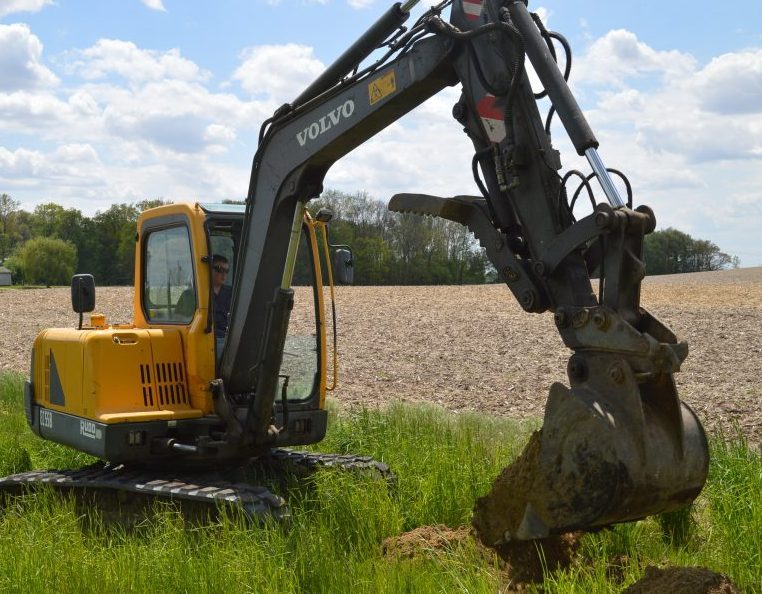Where The Water Goes Is A Big Deal

Chris Moyer of Good Excavating is using digging equipment in an attempt to locate a drainage tile originally installed in 1914 on property located in Prairie Township. Flooding has occurred on CR 700W, north of CR 550N, and the county surveyor’s office was called to address the problem. A nearby field was farmed when the drainage tile was installed but no longer is.
KOSCIUSKO COUNTY — You live next door to someone who is having their property developed and that could mean the landscape is altered. If so, it could also mean it would affect where the water after a rain drains to.
Such a scenario is quite common in Kosciusko County and elsewhere. Obviously, no one likes to see water backed up on their property or standing water on a road they drive upon.
Drainage is an element dealt with frequently by the Kosciusko County Surveyor’s Office. Mike Kissinger, county surveyor, noted there are 1,100 miles of county regulated drains within the county.
Before 1900, landowners — quite often farmers wanting to drain land so they could farm it — came together to seek ways for proper drainage. A board of viewers was created to survey potential drainage sites and landowners paid to have ditches put in. Drainage ditches have names attached to them and typically they were named after the landowner who asked for the ditch to be built.
Today, those drainage ditches, many of them exceeding 100 years of age, are maintained by contractors hired by the county. “We don’t have the equipment to maintain them,” Kissinger noted.
Typically a landowner will call the surveyor’s office if they encounter a drainage problem. Someone is then sent to the site to look at it and see what can be done to fix it.
Kissinger said the county has approximately 140 regulated drains, but some cross over county lines and whichever county has the largest part of the drain is responsible to maintain it. He estimated there are 117 drains Kosciusko County is responsible for maintaining.
Those living within a regulated drain system pay into a maintenance fee, more specifically a drainage assessment. The money is used to help maintain drainage ditches, but unfortunately Kissinger noted several of the drains are in debt status because more has been spent on maintaining them than has been received into the maintenance fee. For the most part (there are exceptions) landowners pay a flat rate per acreage.
In response, the county council created a general drain fund from which funds can be borrowed to repair ditches, but the money must be paid back into the fund. “Ditch money can’t be spread out to other ditches,” Kissinger emphasized. “It must stay within the ditch it was borrowed for.”
A drainage board consisting of five members appointed by the county commissioners can raise the drainage assessment fee if necessary in order to combat the debt problem. A public hearing must be held and input received first though.
There are approximately 250 work order requests yearly, Kissinger said, costing between $500,000 to $600,000.
When property is developed, the goal is for that development not to cause a hardship on drainage for adjoining landowners. “They (developers) have to contain the water and release it at the pre-development rate,” he said.
Designing drainage systems is an art, not a science, he stressed. Water has to be narrowed to fit through pipes and “that can be very tough to do.”
County subdivision plats, which may or may not be connected to a county regulated drain, are reviewed by a technical review committee before being considered by the Area Planning Commission. “We know what plats are supposed to look like,” Kissinger said. “We are licensed surveyors.”
Many subdivisions have water retention ponds and some may be designed to outlet into a county drain. “We must watch to see if the drain can handle the water,” he said. “It may need upgrading by the developer.”
Typical drainage issues include muck ground in the northwest part of the county and removing logs from ditches among others.
Kissinger added it is rare for the county to add a new drainage ditch “because we have drained about everything that can be drained and we are not really adding much new farmland.”
